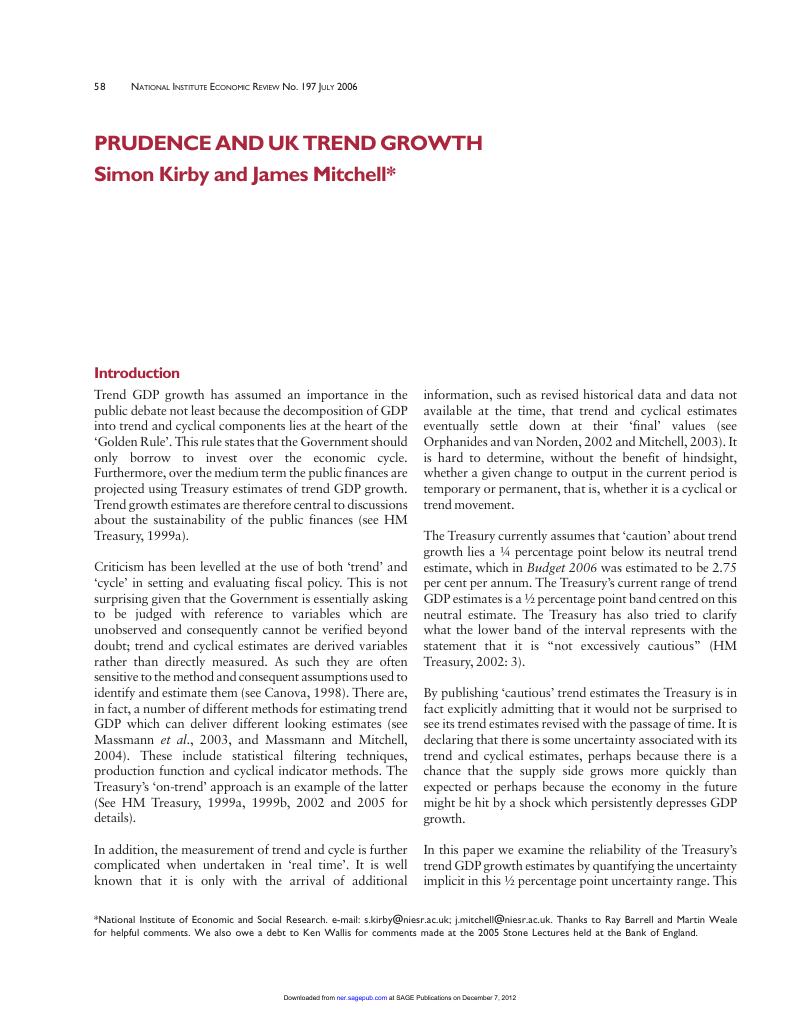No CrossRef data available.
Article contents
Prudence and UK Trend Growth
Published online by Cambridge University Press: 26 March 2020
Abstract
An abstract is not available for this content so a preview has been provided. Please use the Get access link above for information on how to access this content.

- Type
- Articles
- Information
- Copyright
- Copyright © 2006 National Institute of Economic and Social Research
Footnotes
Thanks to Ray Barrell and Martin Weale for helpful comments. We also owe a debt to Ken Wallis for comments made at the 2005 Stone Lectures held at the Bank of England.
References
Anderson, T.W. (1958), An Introduction to Multivariate Statistical Analysis, New York, John Wiley & Sons.Google Scholar
Canova, F. (1998), ‘Detrending and business cycle facts’, Journal of Monetary Economics, 41, pp. 475512.Google Scholar
Christoffersen, P.F. (1998), ‘Evaluating interval forecasts’, International Economic Review, 39, pp. 841–62.CrossRefGoogle Scholar
Clements, M.P. and Hendry, D.F. (1998), Forecasting Economic Time Series, Cambridge, Cambridge University Press.CrossRefGoogle Scholar
Garratt, A., Robertson, D. and Wright, S. (2006), ‘Permanent vs. transitory components and economic fundamentals’, Journal of Applied Econometrics, 21, 4, pp. 521–42.CrossRefGoogle Scholar
Giordiani, P. and Soderlind, P. (2003), ‘Inflation forecast uncertainty’, European Economic Review, 47, pp. 1037–59.Google Scholar
Massmann, M. and Mitchell, J. (2004), ‘Reconsidering the evidence: are Euro-area business cycles converging?’, Journal of Business Cycle Measurement and Analysis, 1(3), pp. 275–307.Google Scholar
Massmann, M., Mitchell, J. and Weale, M. (2003), ‘Business cycles and turning points: a survey of statistical techniques’, National Institute Economic Review, 183, January, pp. 90–106.CrossRefGoogle Scholar
Mitchell, J. (2003), ‘Should we be surprised by the unreliability of real-time output gap estimates? Density estimates for the Euro-area’, National Institute of Economic and Social Research Working Paper No. 225.Google Scholar
Mitchell, J. (2005), ‘The National Institute density forecasts of inflation’, National Institute Economic Review, 193, pp. 60–69.CrossRefGoogle Scholar
National Audit Office (1997), Audit of Assumptions for the July 1997 Budget Projections, June.Google Scholar
Orphanides, A. and van Norden, S. (2002), ‘The unreliability of output-gap estimates in real time’, Review of Economics and Statistics, 84, pp. 569–83.CrossRefGoogle Scholar
Wallis, K.F. (2004), ‘An assessment of Bank of England and National Institute inflation forecast uncertainties’, National Institute Economic Review, 189, pp. 64–71.CrossRefGoogle Scholar


